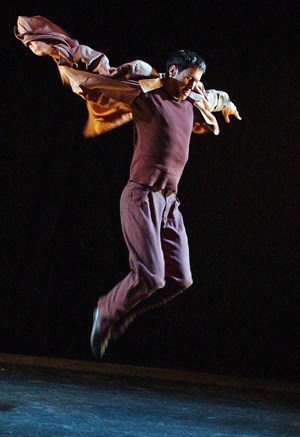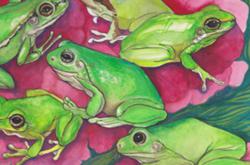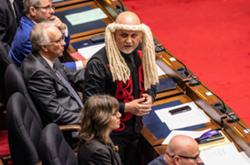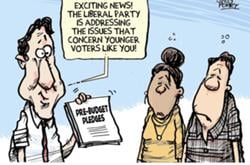
The day after the Stanley Cup riots, Vancouver felt hung over. The city was quiet, slow moving, with residents physically jarred and ashamed of the night's antics.
The term "catharsis" was routinely used in the aftermath. VanCity Buzz called Vancouver's plywood message board catharsis; the Vancouver Sun did the same for The Bay's pancake breakfast. Some even thought that the riots themselves were cathartic -- a release of the slow-built tension over seven games.
For former Ballet BC dancer Edmond Kilpatrick, catharsis came in the form of a contemporary dance piece: Party Boys.
The seven-minute piece debuted in August at the 24th series of Dances for a Small Stage: now a revered fixture in the Vancouver dance scene, featuring work on a 10-by-13 foot stage. While quality is uniformly high, the small stage has an "anything goes" quality: ventriloquists, ballerinas, hip-hop artists and burlesque acts can play and push boundaries. It was an ideal banner under which to choreograph Party Boys, Kilpatrick's response to the riots.
A public venting post
Evolved from a boylesque piece originally intended for the show (in which Kilpatrick throws coffee all over himself), Party Boys begins with three dancers in suits, wandering the stage with no clear agenda. Soon, just like the riots, the calm evolves into a furious masculine chaos. The dancers leap upon one another, moshing together. Their frenetic energy starts kid-like karate fights. They bray and pose in purposeful, over exaggerated movements. It feels primeval. The entire piece shimmers with an underlying sense of danger while testosterone and carelessness bubble over into destruction.
The characters are, Kilpatrick hopes, "a public venting post."
"At one point, I was actually egging on the audience to boo us," he explained, "hoping that they would superimpose on us their feelings for the people they hopelessly watched burn down cars and parts of the city. I was hoping for them to release some of that on to us."
Belly laughs and catcalls filled the auditorium each night as the dancers' one-upmanship became more and more ridiculous.
"It gives everybody a chance to objectively experience [the event] together without it actually happening again," he added. "As a community they can grieve, or reject, or laugh, but they'll have a communal experience of it one more time."
Cabaret: the 'impudent muse'
Kilpatrick's attempted catharsis occurred in the footsteps of traditional cabaret, which critiques a situation by contrasting it with the ideal, often to create a hilarious, even slapstick, result. The audience plays an active role in performances, which closely reflect public opinion and current events.
The Weimar cabaret -- the most prolific example -- was born during the highly politicized 1920s in Germany. A time of flourishing creative movements and ideas, it led to works by some of the finest minds of the 20th century, including Max Ernst, Hermann Hesse, Thomas Mann, Max Reinhardt, Mary Wigman, and Franz Kafka. It's this form that originally inspired Julie-anne Saroyan, curator and artistic director of Dances for a Small Stage 24.
"I started being extremely fascinated by cabaret about a year ago," she said. "I was intrigued by how artists used the platform to make social commentary, and I was hoping that [Dances performers] would do something similar. Edmond really rose to the challenge."
Kilpatrick was quick to point out the political absurdity of the Vancouver riots: "The same night, there were riots in Greece and the Middle East. It's much more obvious that in those places there is a certain frustration built up out of inequality, inopportunity, disparities. Those riots seemed to come from something. Here in Vancouver... Canada has this long-standing tradition of hockey riots, and all these kids wanted to be part of that, and burnt up a town. I wanted to show that absurdity in my piece."
As the Party Boys descend into chaos on stage, they remove items of clothing until they are left standing in a small pair of briefs. The stripping is both comic and symbolic: with each item discarded, so is another layer of personality and self-control.
In the final scene, while one performer works sock puppets between the others' legs, the men look vulnerable. Their absurdity, and the realization of their actions, descends on them until they are left looking like little boys on the darkening platform.
This cabaret-style performance -- with razor sharp observation and a cheeky sense of humour -- provides the Vancouver audience with one of the first refreshing portrayals of the riots since they flamed onto our television screens and social media accounts. We are given a theory of the rioting mindset -- not one as in-depth as psychoanalysis of a lost generation, but an astute one nonetheless. And we are granted permission to laugh at events.
A city divided
The city's opinion about Party Boys is divided, but each audience member has one (and so do some that haven't even seen the show.)
"A lot of people loved Edmond's piece," said Saroyan. "A lot of people really got it. They thought it was a really good statement without being too harsh. And some people didn't like it -- they thought it made the riots seem trivial. But he created a parody and that's another reaction audience members had: that finally someone has said 'This is ridiculous.'"
For Kilpatrick, reconsidering the riots was paramount to his vision, and seems to have worked -- at least for the portion of the audience that appreciated the light-hearted tone.
"I whipped them up a little bit," he said. "But I didn't take them to that place where they would be enraged like they initially were. I'm not saying that they didn't have that anger still, but I think they had a chance to appreciate the absurdity."
By and large, Vancouver has remained indignant about the riots, with a self-conscious fury and earnestness. The pantomime-like exaggeration and crotch sock puppets of Party Boys make us feel how cabaret should: self-assured, with permission to laugh about the perpetrators while still understanding the severity of their crimes. Perhaps it's time we started treating life more like a cabaret.
The next Dances for a Small Stage kicks off at the Shadbolt Centre for the Arts 2011-2012 season, on September 23 & 24, 2011, at 8 p.m. Tickets: $15 at shadboltcentre.com, free for Shadbolt subscribers, or 605-205-3000. Info at: movent.ca. ![]()















Tyee Commenting Guidelines
Comments that violate guidelines risk being deleted, and violations may result in a temporary or permanent user ban. Maintain the spirit of good conversation to stay in the discussion.
*Please note The Tyee is not a forum for spreading misinformation about COVID-19, denying its existence or minimizing its risk to public health.
Do:
Do not: